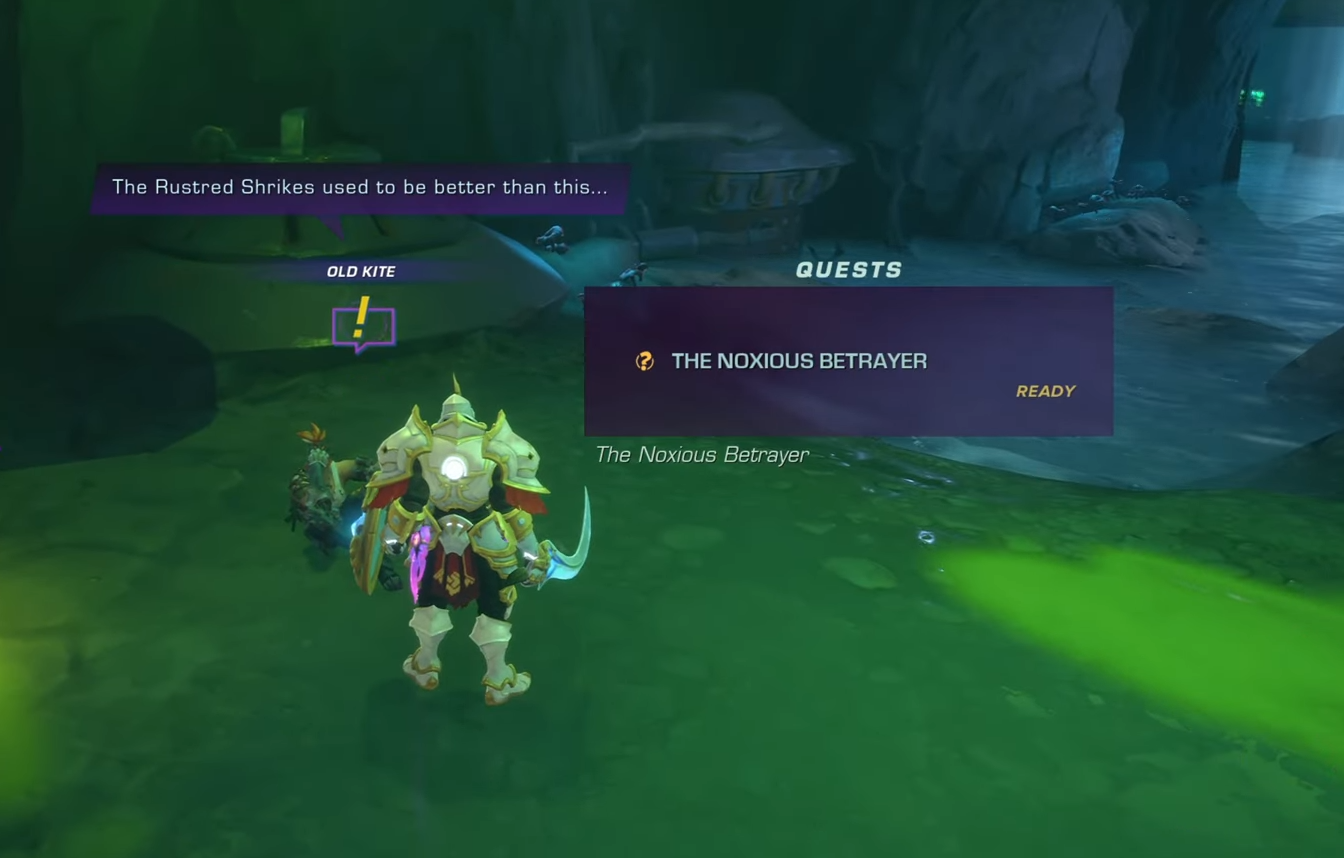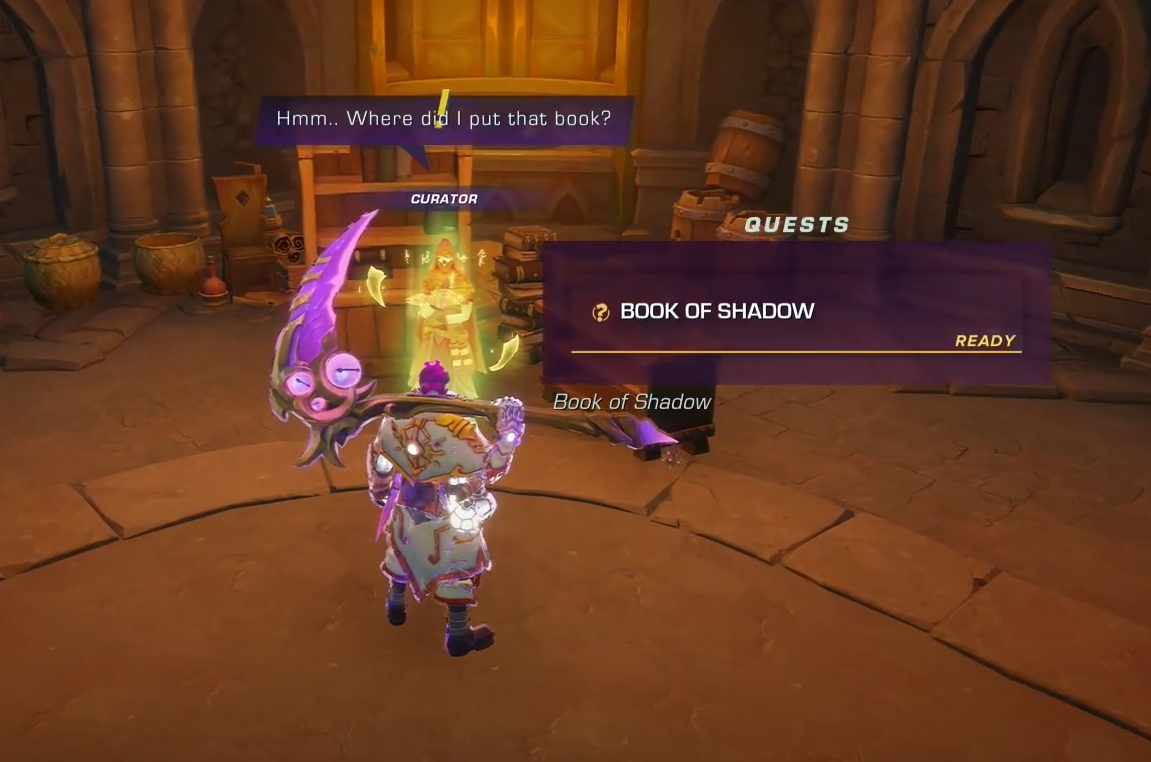Wayfinder
Wayfinder is a Live-Service, Action MMORPG game featuring fast paced Third-Person combat and randomly generated Dungeons. Wayfinders must Control the Chaos as they directly shape and customize the endless adventures with their friends.
During my time working on Wayfinder, my primary responsibility was to design, script, and implement over 100 Quests, including all of the Main Story Quests and the New User Experience. Usually in support of these Quests, I also created many Gameplay Events using Unreal Engine Blueprints.
Role: Game Designer
Project Details:
• Studio: Airship Syndicate
• Worked on the Game for: 2+ Years
• Game Engine: Unreal Engine 4
Highlighted Contributions:
• Main Story Quests
• Gameplay Events for Quests
• New User Experience
Main Story Quests
Working on the Main Story Quests of Wayfinder has been an incredible experience that has ignited my passion for Narrative Design. My role as a Designer on these quests was to create compelling and fun gameplay out of the story the Writer had envisioned. Below is a video of a playthrough of one of my Main Story Quests.
Making Quests:
A lot goes into creating a Main Story Quest. I start out by taking a chunk of the story, written by the Writer, and figure out a series of quest objectives to get from the beginning to the end of that chunk. Before I actually start implementing anything in the editor, I will compile a list of any art assets, world building support, or engineering support I will need. Then, I will prototype out the Quest using Unreal Engine Blueprints, kitbashing art assets together, and writing out temporary dialogue. My goal is always get the quest playable as soon as possible so that my lead and the rest of the Narrative Team can provide feedback on it as soon as possible. While implementing their feedback, I will also go back in an implement work from Artists, Engineers, or from the Writer as they are finished. When a batch of Main Story Quests are ready for feedback to the studio at large, we will schedule playtests for everyone at the studio to jump in and give their thoughts.
MSQ Feedback:
Due to the nature of Main Story Quests being one of the larger and more visible elements of the game, they have often been subject to some of the largest amounts of feedback from the studio. In order to be responsible for this content, I need to remain open to feedback and understand that a lot of people will have different opinions about it. Back when I was an Associate Designer, I wasn’t confident how to best filter feedback that didn’t come directly from a lead. I thought to myself: Should I be implementing all these changes they are asking for? Can I disagree with it? Should I ask my lead what to do? Then considering the nature of making a live service game and releasing in Early Access, I have to think about deadlines and time constraints. And then there is player feedback to take into consideration. Today, I have a bit more experience and have learned that it is less about finding a rigid filter and more about determining what to do based on my best judgement and considering the time and resources it would take to make a change.
Gameplay Events
Events in Wayfinder are Puzzles, Combat Encounters, Trials, Games of Chance, and Narrative Devices that are often randomly generated into Dungeons or out in the world that players complete either by themselves or in a group. I created a fair number of them to be used in Quests.


Dungeon Events:
Often as a part of making the Main Story Quests, I have also designed and created many Events using Unreal Engine Blueprints in Wayfinder. Most of the Events I created were designed to support a Questline I was working on. If a Quest required the player to find and eliminate an enemy in a Dungeon, I would set up a Combat Encounter in an empty Event Level, assign the enemy to the Combat Manager, set the Event to grant the player an “Enemy Defeated” tag when the Encounter is completed, and then set the Event to spawn only when the player is on the right Quest and Quest Objective. I also had the opportunity to work on an Event that was unrelated to Quests that ended up being cut before release. Internally, we called the Event: “Equilibrium”. In this Event, the player would attempt to balance Radiant and Shadow elements to complete the Event. Depending on the balance of the two elements, or the imbalance, players would be rewarded or met with a challenging Enemy Encounter. The Event was designed to be replayable, so players were incentivized to try to find the Event in the Dungeon again next time to obtain different rewards based on how they chose to complete the Event each time.
Dungeon Quests:
Another specific type of event I worked on in Wayfinder were “Dungeon NPC Events”. Each Dungeon has its own exclusive NPC that can only be found within it. These NPCs have their own Questlines the player can follow. I designed these Quests to encourage players to utilize “Imbuements”, elemental modifiers they could apply when entering a dungeon and to incentivize returning to Dungeons they have been to previously. I had a lot of creative freedom with what I could do with these NPCs and their Quests. I wrote the initial story and dialogue for them and created custom Events just for specifically. One Questline was all about tracking down and eliminating the NPC’s former criminal gang who betrayed him. Another was about trying to save a different NPC from turning into a monster by tracking down odd ingredients and brewing mystical potions for them.
New User Experience
The New User Experience is the very first level of the game, and a handful of Quests that extend beyond it, that serves as a tool to tutorialize players on how to play the game and establish the core mechanics present within the game. The video below shows gameplay of the first level of the game that showcases the core of the New User Experience.
Tutorial Level Collaboration:
Creating this section of the game was a collaborative effort across many different professions at the studio, but the core gameplay of the experience was implemented by a Level Designer, a UI Designer, and me. My role was to create the structure for which the players will be introduced to the core mechanics and concepts of Wayfinder through Quests. When I was first brought on to work on the New User Experience, the Level Designer had already completed a first pass on the tutorial level, so I already had a level to work in. Over the course of several meetings, we discussed what needed to be tutorialized and where, but also how to turn that experience into a Quest. After creating a loose Quest skeleton of what we determined needed to be included in this Quest, I got to work implementing the Quest Objectives into the Level and it’s Level Blueprint. Some of my key contributions to this level are: Implementing doors that blocked the player’s path until Combat Encounters were completed, an NPC that grants the player one of the core features of the game, and granting the player a gameplay ability modifier that instantly granted the player their Ultimate Attack during the Boss Encounter. While we were working in the level, the UI Designer was brought in create the UI Tutorial Pop Ups that appearing in each of the Quest Objectives. The finished product is an experience that is crafted to be entertaining and engaging for players, but also teaches them how to play the game.
Iteration:
The New User Experience went through many different iterations to find an important balance of player freedom and “hand holding”. There are a lot of mechanics and other aspects of Wayfinder we needed to teach the player, and a lot that needed to be taught up front. In early iterations for the New User Experience quests, there were many tutorials and objectives tied to them that gated the player from progressing in the story. In playtesting, we found that it was way too much to read in a short amount of time and it slowed the pace at which the player was able to progress further into the game and have fun. Slowly but surely, what we arrived at was keeping only what was absolutely necessary up front in “Chapter 1” of the Main Story Quests and then delaying many of the other tutorials until “Chapter 2”. We also relocated many of the Quest Objectives tied to tutorials to a type of quest we called “Priority Quests”. These quests could be completed at the players own pace and would not prevent the player from progressing in the Main Story Quests until they were completed.
Working on the Main Story Quests as an Associate Designer

When work on Ruined King wrapped up and I was moved over to Wayfinder, I had just been hired on full time as an Associate Designer. Wayfinder was in a stage of development where formal “Quests” did not exist. When Airship Syndicate started experimenting with the idea of adding Quests to the game, I volunteered to design those “Pseudo Quests”. When the day arrived where Wayfinder needed formal Quests to deliver the main story of the game, I found myself in a position where I could take on that responsibility. I was certainly nervous to be working on such a large part of the game as an Associate Designer, because it was a huge step up from the rest of the work I had done in the games industry professionally. If I checked in a Quest that was broken, it would prevent everyone from progressing to content that was gated behind it. Fortunately, I had the two best resources I could have asked for: Enough time to fail and a team of extremely talented Designers to learn from. Through learning from failure, guidance from my peers, and many months of hard work, I was able to improve my Quest Design and obtain confidence in my work. Eventually, I no longer had to worry about an Associate Designer working on the Main Story Quests, because I was promoted to a Mid-level Designer!